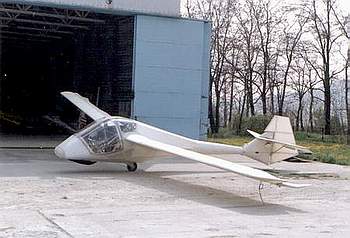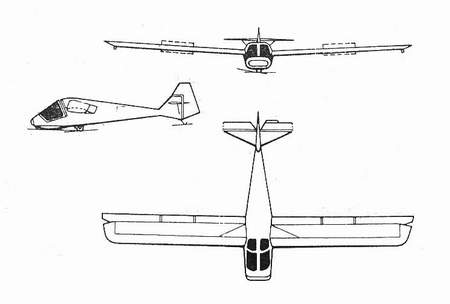HUNGARIAN
GLIDERS
1933-2000
| Type designation: |
R-31 |
| Name: |
Dupla (Double) |
| Designer: |
Ernő RUBIK |
| Class: |
Basic training |
| General arrangement: |
All-metal, mid-wing, cantilever, double-control, side-by-side seats, traditional tail unit, fixed wheel |
| Crew: |
2 |
| First flight: |
1983 |
| Manufacturer: |
Ernő Rubik and the workshop of the National Civil Defence Assiciation (MHSz), Budaörs |
| Number of built: |
1 |

Short history:
The R-31 Dupla was designed by Ernő Rubik, who had been retired for years at the time of the design work. His intention was to create a cheap, light, basic instruction glider, which could be the successor of the phaseing out R-26s Góbé gliders. The structure was designed for permissible load factors of +5,3/-2,7.
Originally it was a private venture of Rubik, who started to build the glider in his own garage. Later the MHSz (the National Civil Defence Association, responsible all technical sports in Hungary) supported him offering to finish the glider in its workshop located in Budaörs, and to execute the test flights. The glider got only a temporary certification to conduct the test flights.
The glider first flew in 1983 and was tested between 1983 and 1986. 26 flights were executed with 8 hours total time.
The test flights finally were abandoned as vibration had occurred at all speed ranges. Her performances were well under that those of the R-26s Góbé. The procect was dropped as the R-31's performance as well as flight handling characteristics had not been suitable to prepare student pilots to fly such gliders as the SZD-30 Pirat.
Structure: All-metal
Wing:
The constant chord wing had rounded wingtips with wingtip skids. In front of the main spar the wing was covered with Rubik-type corrugated light metal plates and behind the spar with canvas. The trailing edge type airbrake was fitted just inside of the slotted aileron, and had an extreme deflection of 90 degrees. No aerodynamic or geometric washout was applied on the wing, however the tips of the ailerons were curved upward.
Fuselage:
The front part of the fuselage was of a tube-girder structure with light metal plate and canvas skin. The fuselage behind the wing was cone-shaped with light metal plate skin. The two part canopy's front part opened upward, the rear part was fixed. One control column was fitted between the two seats. Handles fitted on the ends of a paralellogram cross bar on the top of the column served as individual control sticks for the two pilots. The airbrake handle was located in the center-line above the pilots' head.
Tail unit:
The control surfaces of the traditionally arranged tail unit were covered with canvas. The horizontal stabilizer was strutted.
.jpg)
.jpg)

| Dimensions: |
| Wing: |
| Span, m: |
13,0 |
| Area, m2: |
15,0 |
| Aspect ratio: |
11,3 |
| Chord (root), m: |
1,2 |
| Chord (tip), m: |
1,2 |
| Airfoil (root), m: |
? |
| Airfoil (mid-span), m: |
? |
| Airfoil (tip), m: |
? |
| Dihedral, degree: |
3 |
| Sweep, degree: |
0 |
| Washout: |
Geometric |
| Aileron: |
| Span, m: |
4,8 |
| Mean chord, m: |
0,36 |
| Total area, m2: |
cca. 1,66 |
| Balancing: |
Aerodynamic |
| Flap: |
| Type: |
Slotted |
| Area, m2: |
1.52 |
| Relative length, %: |
0.33 |
| Movement (+/-), degree: |
?/? |
| Airbrakes: |
| Type: |
Trailing edge |
| Position (upside/downside): |
u/d |
| Total area, m2: |
cca. 0,97 |
| Position, % of chord: |
Trailing edge |
| Horizontal stabilizer: |
| Span, m: |
2,9 |
| Area, m2: |
0,88 |
| Elevator: |
| Span, m: |
2,9 |
| Area, m2: |
0,87 |
| Airfoil: |
? |
| Balancing: |
None |
| Trim: |
Yes |
| Vertical stabilizer and rudder: |
| Total area, m2: |
1,27 |
| Rudder area, m2: |
0,87 |
| Balancing: |
Aerodynamic |
| Fuselage: |
| Length, m: |
7,5 |
| Width, m: |
1,18 |
| Height: |
1,36 |
| Cross section, m2: |
? |
| Landing gear: |
| Type: |
Fixed |
| Wheel diameter, m: |
0,3 |
| Masses: |
| Wing, kg: |
? |
| Fuselage, kg: |
? |
| Tail unit, kg: |
? |
| Empty glider, kg: |
188 |
| Gross, kg: |
390 |
| Ballast, kg: |
None |
| Wing loading, kg/m2: |
26,0 |
| Speeds: |
| VNE, km/h: |
160 |
| Max. speed with open airbrakes, km/h: |
160 |
| Max. aerotow speed, km/h: |
100 |
| Max. winch speed, km/h: |
100 |
| Max. speed in rough air, km/h: |
140 |
| Stall speed, km/h: |
55 |
| Performance: |
| Min. sink, m/s (at gliding speed, km/h): |
cca. 1,3/72 |
| Best L/D (at gliding speed, km/h): |
22/? |
| Start methods: |
Winch, Aerotow |

Origin of data and 3-view drawing:
Jereb Gábor: Magyar vitorlázó repülőgépek, Műszaki Könyvkiadó, 1988, Budapest
(Gábor JEREB: Hungarian Gliders, Technical Publishing House, 1988, Budapest)
Gábor FEKECS E-mail: fekecs.gabor@t-online.hu

.jpg)
.jpg)
